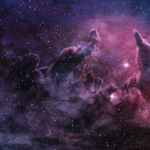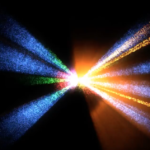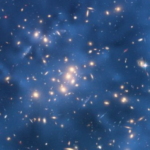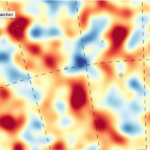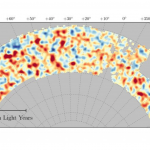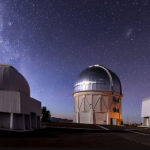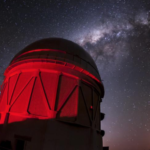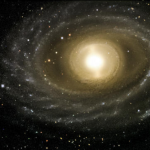All the news about DES that’s fit to print!
Australian Scientists Just Made A ‘Beyond Exciting’ Dark Matter Discovery
University of Queensland researchers have joined an international team of more than 400 scientists from 26 institutions to create the most accurate measurement ever made of dark matter structure in the universe.
UQ School of Mathematics and Physics Cosmologist Professor Tamara Davis said the Dark Energy Survey showed a stunning map of the distribution of dark matter.
“The survey supports the view that dark matter and dark energy make up most of the cosmos,” she said. “We have been working with the international team for the past five years, so it is thrilling to see that work come to fruition with these first major results.”
DES+OzDES, WiggleZ, GAMA, 2dF, 6dF, & SDSS – 3D Galaxy Visualization
This wonderful animation is made by DEScientist Samuel Hinton of University of Queensland, Brisbane, Australia. In this animation we are at the centre, and the dots represent galaxies we have observed. Their distances are measured using “redshift” – a change in the object’s colors due to the stretching of space.
Orange dots are galaxies in the DES + supernovae measured by OzDES. Gold/orange is DES, Blue is WiggleZ, Green is GAMA, Red is 2dF, Yellow is 6dF, Purple is SDSS.
Unlocking the secrets – and possible uses – of dark matter
Flying cars could be one step closer thanks to a study on dark matter and energy conducted by Australian and international scientists. The researchers were part of an international team that included 400 scientists across six continents.
University of Queensland astrophysics professor Tamara Davis was one of the Australian researchers that contributed to the project. “Dark matter is the scaffolding that holds galaxies together, they spin way too fast to hold themselves together,” she said.
The same article is repeated in The Sydney Morning Herald, The Canberra Times & The Brisbane Times.
Accurately measuring the dark universe
The theory that dark matter and dark energy make up most of the cosmos has been confirmed by extremely accurate measurements from the Dark Energy Survey (DES) collaboration involving UCL scientists. The findings verify that only 4% of the universe is made of ordinary matter, 26% is in the form of mysterious dark matter and space is filled with an unseen dark energy, which is causing the accelerating expansion of the universe and makes up 70%.
“It is remarkable that dark energy, proposed in its simplest form by Einstein 100 years ago, is now measured so accurately by DES. However, the nature of dark energy is still a big mystery,” said Professor Ofer Lahav (UCL Physics & Astronomy), chair of the DES:UK Consortium and chair of the DES Advisory Board.
Dark Energy Survey reveals most accurate measurement of dark matter structure in the universe
If you think of the seed as the early universe, and the tree as the universe the way it looks now, you have an idea of what the Dark Energy Survey (DES) collaboration has just done. University of Michigan (U-M) physicists including August Evrard, David Gerdes, Dragan Huterer, Chris Miller, Gregory Tarlé, and research scientist Michael Schubnell; 7 graduate students, and dozens of undergraduate students have contributed over the years to DES by providing major components of the DES camera. The U-M research team continues active ongoing roles in survey operations and data analysis for DES.
Our clumpy cosmos
“The DES measurements, when compared with the Planck map, support the simplest version of the dark matter/dark energy theory,” says Joe Zuntz, of the University of Edinburgh, who worked on the analysis. “The moment we realized that our measurement matched the Planck result within 7 percent was thrilling for the entire collaboration.”
NCSA processes big data with breakthrough results for Dark Energy Survey
New measurements from data processed by the Dark Energy Survey Data Management (DESDM) project at the National Center for Supercomputing Applications at the University of Illinois at Urbana-Champaign verify the theory that 26 percent of the Universe is in the form of mysterious dark matter and that space is filled with an also-unseen dark energy, which is causing the accelerating expansion of the universe and makes up 70 percent of the Universe’s contents. “NCSA recognized many years ago the key role that advanced computing and data management would have in astronomy and is thrilled with the results of this collaboration with campus and our partners at Fermilab and the National Optical Astronomy Observatory,” said NCSA Director, Bill Gropp.
Map of the cosmos ‘sees’ the dark universe
For the first time, scientists from the international Dark Energy Survey (DES) collaboration can see the structure of the current universe in contrast to the universe at its very beginning – and therefore can answer many questions about how it evolved.
The UK has been involved in this international project from its conception, back in 2004, with the Science and Technology Facilities Council (STFC) providing funding on behalf of the UK.
The DES collaboration is led by Fermilab in the US and is made up of more than 400 scientists from 26 institutions in seven countries, with UK astronomers playing a key role. Scientists at the universities of Cambridge, Edinburgh, Manchester, Nottingham, Sussex, Portsmouth and UCL have led work central to today’s results
Dark Energy Survey reveals most precise measure of universe’s structure
If you think of the seed as the early universe, and the tree as the universe the way it looks now, you have an idea of what the international Dark Energy Survey collaboration has just done. Scientists unveiled their most accurate measurement of the present large-scale structure of the universe at a meeting Aug. 3 at the University of Chicago-affiliated Fermi National Accelerator Laboratory. UChicago, Argonne and Fermilab scientists are members of international Dark Energy Survey collaboration.
Penn Astronomers Contribute to the Most Accurate Measurement of Dark Matter Structure in the Universe
For the past four years, as part of a project called the Dark Energy Survey, a team of scientists from around the globe has aimed one of the world’s most powerful digital cameras towards the sky with the hopes of answering fundamental questions about the universe.
“One of the things that the Dark Energy Survey is investigating is the 20-year-old discovery that the expansion of the universe is accelerating, which wouldn’t happen in a ‘normal’ universe,” said Gary Bernstein, Reese W. Flower Professor of Astronomy and Astrophysics in the School of Arts & Sciences at the University of Pennsylvania and Project Scientist for DES. “There’s something in the universe, which we call dark energy, that’s causing this space to basically repel itself and grow faster and faster.”
Penn astronomers are playing an integral role in this team and its mission. The survey officially began in August of 2013, the culmination of 10 years of planning, building and testing by more than 400 scientists from 26 institutions in seven countries.

